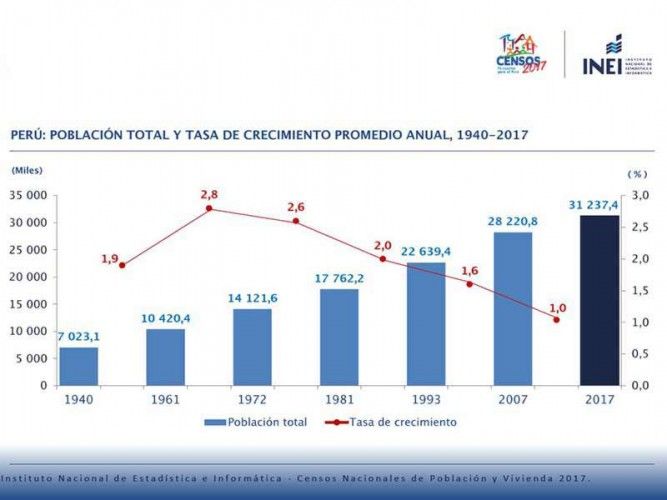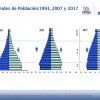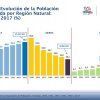After months of delays the head of Peru’s Institute of Statistics (INEI), Francisco Costa yesterday finally presented the first results of the population census conducted in October 2017.
Total population of Peru 2017
According to the press release “Censos Nacionales 2017 – Primeros Resultados” Peru’s population grew by only 1% annually since the last census in 2007. On October 22, 2017, the day of the census, a total of 31,237,385 citizens lived in Peru. This figure is composed of 29,381,884 residents that were actually counted and 1,855,501 residents that were absent. At the end of this article you will find the press release as a PDF.
This makes Peru the 5th most populated country in South America after Brazil (211.2 million citizens), Colombia (49 million citizens), Argentina (44.1 million citizens) and Venezuela (32.1 million citizens) and before Chile (18.2 million citizens), Ecuador (16.6 million citizens), Bolivia (11 million citizens), Paraguay (6.8 million citizens) and Uruguay (3.5 million citizens).
From the 29,381,884 inhabitants that were counted 50.8% (14,931,127 citizens) were women and 49.2% (14,450,757 citizens) were men.
Peruvian age pyramid 2017
The latest census as well revealed that over the past 25 years the population pyramid changed significantly in Peru (see graphic below). While in 1993 37% of the population was between 0 and 14 years of age, 56% between 15 and 59 years of age and only 7% over the age of 60, in 2017 only 26% of the population was between 0 and 14 years of age, already 62% between 15 and 59 years of age and nearly 12% over 60 years.
Additionally, the overall demographic dependency fell from 71 dependents in 1993 and 58 in 2007 to 53 in 2017. While in 1993 there have been 63 minors and 8 seniors to every 100 inhabitants between the age of 15 and 64 and in 2007 there still have been 48 minors and already 10 seniors to every 100 inhabitants between the age of 15 and 64, in 2017 the number of minors per 100 inhabitants between the age of 15 and 64 decreased to 40 and the number of seniors increased to 13.
With the increasing economic growth and the slowly rising prosperity we saw over the last two decades in Peru, the country shows the first signs of an aging population which will pose new problems and challenges for Peru in the future.
Population distribution in Peru 2017
According to the results of the census 58% of the Peruvian population lives on the coast (+3.4% compared to 2007), 28.1% of Peru’s residents live in the Peruvian highlands (-3.9% compared to 2007) and 13.9% of Peru’s inhabitants live in the Amazonian lowlands (+0.5% compared to 2007). The graphic below shows the development of the population distribution in Peru by natural region from 1940 to 2017.
About a third of Peru’s population (9,485,404 inhabitants) lives in the Lima region; 8,574,974 inhabitants in the Peruvian capital with its 43 districts itself and additionally 910, 431 citizens in the Lima region comprising of 9 provinces.
9,569,468 citizens call the Lima Metropolitan Area which is composed of the City of Lima with its 43 districts and 8,574,974 inhabitants and the adjoining Constitutional Province of Callao with 7 districts and 994,494 inhabitants home.
More results of the Peruvian population census 2017 expected in the coming months
These are only the first results of the Peruvian population census. INEI informed that more detailed information and analyses will be published over the coming months including a deeper insight in the population distribution on August 7, 2018, the characteristics of housing and living conditions in Peru on August 14, 2018, the Peruvian sociodemographic profile on August 21, 2018, the employment situation in Peru on October 25, 2018, the poverty map of Peru on November 25, 2018 and the demographic atlas of Peru on November 30, 2018.





